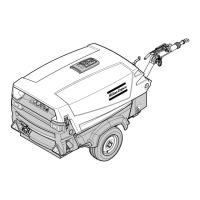57
Instruction Manual
6. PROBLEM SOLVING
It is assumed that the engine is in good condition and that there is
adequate fuel flow to the filter and injection equipment.
Make sure that the wires are not damaged and that they are clamped
tight to their terminals.
6.1 ALTERNATOR PRECAUTIONS
1. Never reverse the polarity of the battery or the alternator.
2. Never break any alternator or battery connections while the
engine is running.
3. When recharging the battery, disconnect it from the alternator.
Before using booster cables to start the engine, be sure of the
polarity and connect the batteries correctly.
4. Never operate the engine without the main or voltage sensing
cables connected in the circuit.
An electrical fault must be traced by an electrician.
If it’s not possible to solve the problem with this
problem solving table, please consult Atlas Copco.
Problem Possible faults Corrective actions
1. Lamps (H1, H2) do not light
up when switching (S1) to ”I”
and applying lamp test.
a. Discharged or defective battery.
b. Loose battery cable(s) or oxidised terminals.
c. Loose connection or damaged wiring.
d. Contact switch (S1) defective.
e. Circuit breaker (F1) defective.
a. Check electrolyte level and charge battery. If
no cells are shorted and battery is discharged,
trace cause and correct.
b. Check and correct if necessary.
c. Check wiring and connections; correct if
necessary.
d. With (S1) switched in ”I”, check voltage
between earth and respectively each of the
terminals of (S1).Voltage must register at each
of the terminals; if not, replace (S1).
e. Replace circuit breaker.
2. General alarm lamp (H2)
does not light up when
switching (S1) to „ I“; lamp
(H1) lights up when applying
lamptest.
a. Lamp (H2) blown.
b. Alternator (A)/regulator defective.
a. Replace lamp.
b. Disconnect the wire from alternator terminal
D+ and connect it to terminal D–. If (H1) lights
up, replace the alternator; if not, test (S1); see
remedy 1d.
3. Temperature alarm lamp (H1)
does not light up when
switching (S1) to „ I“ and
applying lamp test.
a. Lamp (H1) blown
b. See fault 1d.
a. Replace lamp.
b. See 1d.
4. Starter motor (S) does not
crank engine (E) after
switching startbutton (S1) to
””.
a. Low battery output. a. See remedy 1a.
5. Starter motor cranks engine
when switching start switch
(S1) to ” ”, but engine
does not fire.
a. Contact switch (S1) defective.
b. Fuel solenoid (Y1) defective.
c. Low battery output.
a. See remedy 1d.
b. Check solenoid and its valve, correct or
replace if necessary.
c. See 1a.
6. Engine fires, but general
alarm lamp (H2) remains
alight; engine stops when
releasing start switch (S1).
a. Alternator drive belt broken or slipping.
b. Alternator (A)/regulator defective.
a. Check and correct if necessary.
b. Have assembly repaired.
7. Engine is running, but shuts
down immediately after (S1)
has been released.
a. Contact switch (S1) released too soon.
b. Insufficient engine oil pressure.
c. Fuel tank contains insufficient fuel.
a. Release switch after engine oil pressure has
built up above the minimum allowed value.
b. Stop at once, consult the Engine Operation
Manual.
c. Fill fuel tank.
8. General alarm lamp (H2)
remains alight for over 5
seconds after starting.
a. Insufficient engine oil pressure or too high engine
oil temperature.
b. Engine oil pressure switch (S3), or compressor
temperature switch (S5) defective.
c. Relay (K1) defective.
a. Stop at once, consult Engine Operation
Manual.
b. Stop at once, test switches, replace as
necessary.
c. Replace (K1).

